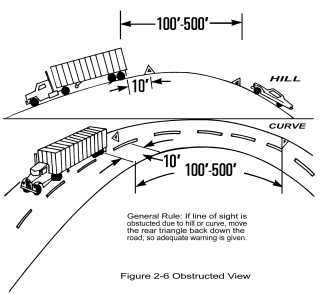When driving a Commercial Motor Vehicle (CMV), the accident possibility and probability increase in direct proportion to the amount of traffic around the CMV. The heavy-duty trucks on the road today are more of a target than a small car. They are easier to hit, they move laterally more slowly, and take up a lot more room. They are an attraction to others drivers’ eyes.
Parking vehicles in the emergency lane is not a recommended procedure unless a viable emergency exists, which means that the truck is broken down and cannot move. There is no practical reason to park a truck in the emergency lane for a non-viable emergency.

Reflector Placement in the Emergency lane:
Although the DOT Regulations book says that the driver only has to put them out at 200 feet, it is desirable and safer to put them out at 500 feet. This is a distance of just under 1/10 of a mile. At 60 miles per hour, a driver in the lane next to the truck will travel 1/10 of a mile in 1/10 of a minute or six seconds. 500 feet give oncoming traffic more time to perceive, react and move over. If the reflectors are only 200 feet out, the oncoming traffic only has 2 ½ seconds to move over.
Another DOT Regulation says that you do not park your equipment where someone cannot see it. So if you are behind an off-ramp, bridge or any other obstruction, make sure you have enough reflectors far enough back to warn oncoming traffic. Emergency lane parking is one of the ballooning types of accidents around the country, so all drivers and students should be made well aware of the warnings, regulations and precautions surrounding this topic.

